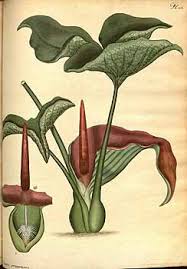Botanical name: Typhonium trilobatum
Common name: Bengal Arum, Lobed Leaf Typhonium
Vernacular name: கருணைக்கிழங்கு karu-nai-kil-an-gu
Useful parts: Tuber
Description of the plants medicinal uses by Sage Agasthiya’s in his text Patharthaguna Chinthamani.
அகத்திய முனியின் பதார்த்த குண சிந்தாமணி என்கிற நூலில் அணைத்து பதார்த்தங்களுடைய குணங்களை விரிவாக கூறியுள்ளார் , அவையிலிருந்து சில பாடல்களை எடுத்துக்காட்ட முயற்சிக்கிறோம்.
காட்டுக் கருனைக்கிழங்கின் குணம்
மேகமனுகாது வெகுதீ பணமாகுந்
தேகமதில் மூலமுளை சேராவே – போகாச்
சுரதோஷம் போங்கரப்பான் றேன்றும் வனத்திற்
பரவு கருனைக்கிழங்காற் பார்.
(இ .ள்.) காட்டு கருனைக்கிழங்குக்கு வாதம் பிரமேகம் முளை மூலமும் சுரதோஷமும் மிகுபசியும் கரப்பானும் உண்டாம்.
Medicinal uses:
Bengal Arum is a prominent herb in Indian medical system both in Ayurveda and Siddha medical system. Tuber of this plant is applied as poultice for healing scirrhous tubers, headache, skin eruptions, traumatic injury, rheumatism etc. It helps in handling diarrhea, dysentery and menstrual troubles. Leaves and tubers are cooked and given to patients suffering from piles and rheumatism. It includes anti-inflammatory and anti-microbial activity. It is used for treating parasitic diseases such as Filariasis, Elephantiasis.
Home remedy:
Boiled Bengal Arum is eaten with banana to relax the bowel system and to provide relief for hemorrhoids. Leaves and tubers are cooked and used to heal piles, enlargement of spleen and rheumatism.
Sources:
- Indian Medicinal Plants: An Illustrated Dictionary By C.P. Khare p.678
- Analgesic, anti-inflammatory and anti-diarrheal activities of ethanolic leaf extract of Typhonium trilobatum L. Schott Khadem Ali, Ayesha Ashraf, and Nripendra Nath Biswas
- பதார்த்த குண சிந்தாமணி – அகஸ்தியர்




